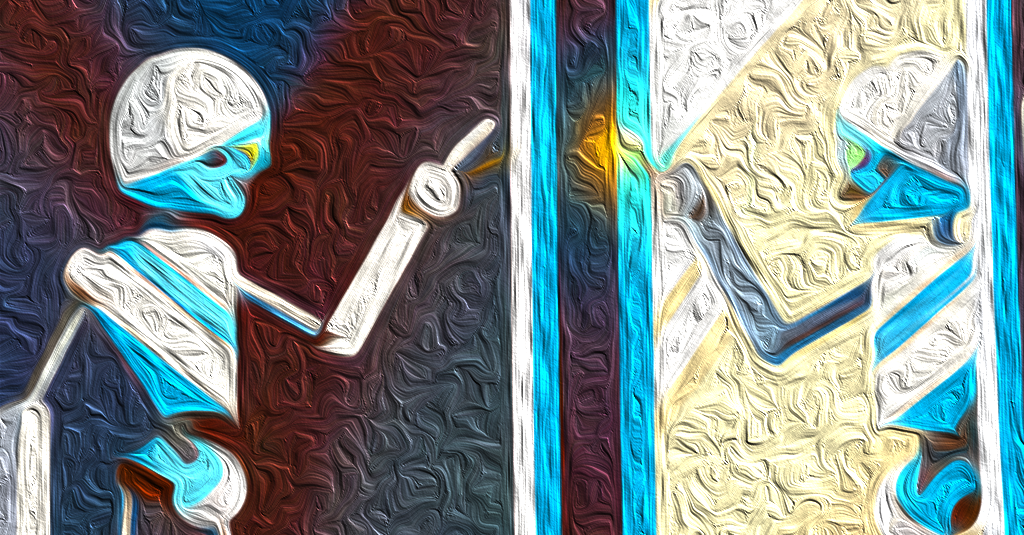Am I a Bot?

A month or so ago a reader of these pages wrote in to let me know she had concluded that my essays had been written by “a particularly dim-witted Artificial Intelligence bot.”
Well! I’ve received many critical and intemperate responses to these writings over the years, but that was the first time I’d been accused of being an AI bot. So I decided to look into it.
In case you’re wondering, “bot” is short for “robot,” but is usually used to mean a software application that performs automated tasks that would normally drive a human being crazy, and to perform them vastly faster. According to the “Bot Traffic Report,” more than half of all Internet activity is generated by bots.
Some online bots are helpful, e.g., search engines, while some are harmful, e.g., malicious attacks. It is well-known that bots are used on Amazon, the Apple app store and other sites to increase positive reviews of products. If you are wondering why you encounter CAPTCHA when you’re trying to enter information on a website, it’s because CAPTCHA is the most widely used technique to determine that you aren’t a bot.
But I suspect that what my indignant correspondent meant was that I was using some sort of AI bot to write my essays, merely appending my name at the bottom after the (not very smart) bot had done all the work. To understand whether such a thing would even be possible, it will be necessary to take a brief look at the history of artificial intelligence and, especially, of AI bots.
We’ll begin with Alan Turing, since CAPTCHA is an acronym that stands for “Completely Automated Public Turing test to tell Computers and Humans Apart.” Turing is widely considered to be the father of Artificial Intelligence, as well as some other important things – computer science, for example.
In his spare time during World War II Turing’s extraordinary work at Bletchley Park – breaking the German codes – was considered by British Intelligence to have shortened the war by two years. A film was made about this event starring Benedict Cumberbatch– The Imitation Game (2014).
In addition, it was discovered earlier this year that the “Turing pattern,” which describes how tigers get their stripes and jaguars get their spots (differential diffusion, in case you’re interested), also explains how humans get their fingerprints. I’ve mentioned Turing before in these pages because one of my characters, Lady Jean Fforde, worked with Turing at Bletchley Park.
In any event, in 1936, at the age of 23, Turing published a paper titled, “On Computable Numbers, with an Application to the Entscheidungsproblem,” that has been called “easily the most influential math paper in history.” That paper proposed the idea of a “Universal Machine” – now called a Turing machine – that could, in effect, calculate anything that is calculable. Nearly ninety years later, Turing machines remain central to the study of computational theory.
But the aspect of Turing’s thought that interests us here is the allied field of what Turing called “machine intelligence,” what is now known as Artificial Intelligence. Turing noted that his (abstract idea of a) computing machine worked by scanning data in its huge memory. The scanner is controlled by a program of instructions and those instructions are also stored in the memory (what Turing called his “stored-program” idea).
Implicit in this idea is the possibility that the machine could act on, modify, and even improve on its own program. During the war Turing was unable to work further on machine intelligence, but his friends reported that he often spoke about how computers could learn from experience, what we now call heuristic thinking.
As early as 1945, Turing predicted that someday computing machines would be able to train themselves so well they would be able to play very good chess – and of course in 1997 an IBM computer beat Garry Kasparov.
On the other hand, as someone has pointed out, a computer beating a grandmaster is about as interesting as a bulldozer lifting more weight than a man. The IBM Deep Blue computer that beat Kasparov was simply able to crunch and evaluate millions of moves very rapidly. It wasn’t able to “think.”
How do we know whether a computer is “thinking?” A few years after World War II Turing introduced the “Turing test,” a fundamental advance in machine intelligence. The test requires an interrogator to determine which of two respondents is a computer and which is a human. The test is enormously complex – for one thing, the computer can cheat, trying to bamboozle the interrogator into thinking it is a fallible human.
Over the decades many implausible claims were made for AI, but today AI has proven to be commercially successful, for example, in chatbots, those little text boxes on websites that urge us to “chat” with them, often showing a photo of an attractive woman nearby.
Studies have shown that many people believe they are actually chatting with a human being when they are talking with a chatbot, and, indeed, some people can’t be talked out of that illusion. Companies love chatbots because they are far cheaper than human employees (and far less troublesome), but also because surveys show that people would rather engage with a chatbot that speaks English than with a human being with an indecipherable accent.
But chatbots, at least the kind typically found on customer service websites, aren’t really thinking machines. They work by having a large memory of keywords and phrases that customers typically use, and then they spit out preprogrammed answers. The chatbots can “learn,” but only in a crude sense, and they require constant tweaking.
Cartoonists are fond of poking fun at chatbots, like this one from Dilbert published earlier this year:
Chatbot: Hello, I am the customer service chatbot. How may I frustrate you?
Dilbert: I want to know how to add a beneficiary to my retirement account.
Chatbot: Thank you for your feedback! Does this webpage on how to cut your own hair answer your question?
Nonetheless, just in the past ninety days thinking machines have exploded onto the national consciousness, thanks to a remarkable generative AI system called ChatGPT. We’ll take a look at that next week.
Next up: Am I a Bot, Part 2











